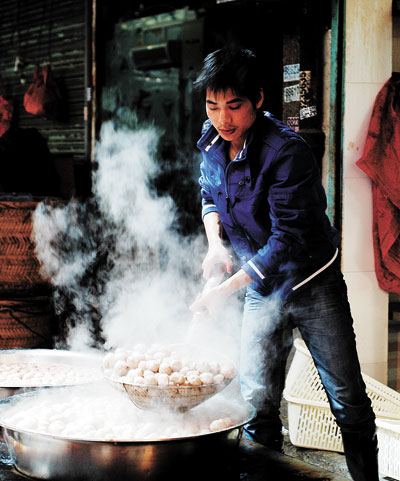|

Tan Yifan
cicitan2011@gmail.com
SOUTHERN Chinese culture is mainly influenced by the Chaoshan, Guangfu and Hakka people. Endowed with unique languages and histories, the three cultures are able to distinguish themselves in such a culturally diverse country.
While the Chaoshan culture is probably the most prominent in the area, it is also quite a reserved and elusive culture. Chaoshan people, who are mainly scattered throughout Shantou, Chaozhou, Jieyang, Shanwei and Meizhou in Guangdong Province, speak one of the most difficult dialects in China, the Chaozhou dialect, and are regarded as business savvy and excellent gourmets.
“You may learn their culture by reading articles or doing business with them, but the best and easiest way to get to know them is to start with the food they serve you,” said Huang Jinglin, author of “The Authentic Taste of Time in Chaoshan Food” (“Chaoshan De Yuanwei Shiguang”). Huang is a Tianjin-born gourmet who has recorded hundreds of Chaoshan foods and included a food-themed travel map in her book.
“It might be a surprise for those who first step into a Chaoshan community to find that these people don’t really care about what they wear in their daily lives. They look sloppy, especially when they head to a local market; instead, they focus on what they put into their bodies. They are the best chefs you can find in all of China and are the masters of life.”
Living as a southerner, you may not realize just how much of what you eat at Cantonese restaurants actually originated in a Chaoshan kitchen, but once you stroll in a small Chaoshan city or town like Huang did or open her book, you will be awed by countless dishes cooked by Chaoshan chefs or mentioned in the 300-page book that explains Chaoshan life methodologies, preferences and personalities.
Like most Chinese, Chaoshan people cannot bear the waste of food, even a grain of rice. They have learned to cook all edible materials into appealing dishes, and they cook it to perfection.
Living in a place with long days, extra sunshine, many rainy days and long coastlines, rice and seafood are the two main ingredients in Chaoshan food. Around 100 known snacks have sweet or salty fillings and are wrapped with rice skins. They also eat large bowls of porridge with chopped, pickled vegetables. For fresh dishes, Chaoshan people love to have a plate of boiled or simply cooked seafood as one of their main dinner dishes. They are masters of cooking various fish and never resist a chance to savor the freshness and sweetness of shellfish. Also, as Huang wrote in the book, Chaoshan people enjoy a wide selection of vegetables. They eat leaves of lyceum, which taste bitter, and urtica, which may cause a burning sensation on the skin.
“Chaoshan people would love to pay over 1,000 yuan to prepare a dish, but if you sit in a small, cheap Chaoshan food stall, you can treat yourself to a feast that tastes just as good as those served in a fancy Chaoshan restaurant,” Huang said.
“A real Chaoshan chef cooks certain foods in an old-fashioned way and follows strict rules,” Huang said. “Take making beef meatballs as an example, chefs prefer to hold thick steel rods in both hands and then hit the meat until it becomes a paste. Only by doing so can the meatballs become al dente.”
In addition to the pursuit of the best food, Chaoshan people have also learned to stimulate their taste buds by adding contradictory flavors to their dishes.
“The two main flavors in Chaoshan food are salty and sweet,” Huang said. “You can easily find those two flavors in a snack or a dish at a Chaoshan banquet.
“They like strong flavor contrast and they somehow find the right balance, just like their complicated personality, which is both traditional and open-minded.”
As more Chaoshan people have settled worldwide, travelers now find it very convenient to dine at an authentic Chaoshan restaurant. Even at Chinese restaurants from other parts of the country, one can usually find a trace of Chaoshan cuisine.
“Many of us may have heard of the Chaoshan culture, but when it comes to the details, hardly anyone can explain the characteristics of it,” Huang said.
“But if we try to explore their cultural uniqueness by having a bite of their food, we may not feel like a complete outsider,” added Huang.
|

